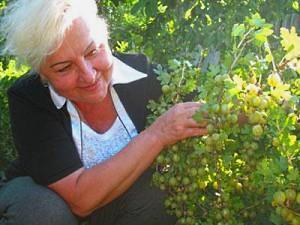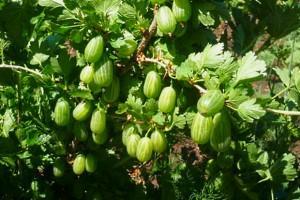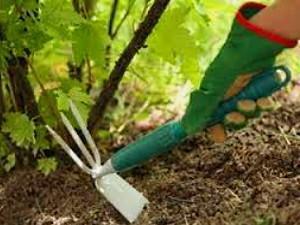How to properly care for gooseberries
 When a summer resident gardener decides to start breeding gooseberries, there are many questions that need to be studied (where and how to plant, which insects to protect from, how and when to cut). The most important issue is the care and cultivation of gooseberries.
When a summer resident gardener decides to start breeding gooseberries, there are many questions that need to be studied (where and how to plant, which insects to protect from, how and when to cut). The most important issue is the care and cultivation of gooseberries.
The primary task for the gardener is to choose a suitable place for planting young gooseberry shoots. This plant is very fond of a lot of light, so it should be planted in an open area, away from tall trees.
Best gooseberry bushes plant into the soil in late September - early October. This is done in order to adapt to a new place before the onset of frost. In early spring, a young shrub can use the full potential of nutrients and soil moisture reserves. By the fall, with proper care for the gooseberry, the bush will noticeably grow.
 Autumn planting is more related to the Western European varieties of Grossularia reclinata (Z) Mill (Warsaw, Industry, Brazilian, bottle, Murera Seed, green). They differ in average height. Buds in these varieties wake up early (April 3-20), when the air temperature does not exceed 100C. In appearance, the fruits are large, the leaves are small, the bushes are small.
Autumn planting is more related to the Western European varieties of Grossularia reclinata (Z) Mill (Warsaw, Industry, Brazilian, bottle, Murera Seed, green). They differ in average height. Buds in these varieties wake up early (April 3-20), when the air temperature does not exceed 100C. In appearance, the fruits are large, the leaves are small, the bushes are small.
If in the future caring for the plant is not sufficient, then its growth will dull. The reason for this is the untimely provision of the gooseberry with moisture and fertilizing.
It should be remembered that gooseberries grow very early. It largely outstrips the development of roots. Therefore, to obtain an excellent result, it needs careful care.
Read also the article:gooseberry diseases and their treatment!
Gooseberry Care Tips
In order to provide the plant with proper care, it is necessary to have information about some of the principles and features of the development of fruit and berry crops.
Care Tips:
 Periodically, you need to monitor the soil around the bush. Gooseberries feel comfortable in loose soil. Therefore, in the fall it is necessary to fluff it up, freeing it from weeds. This must be done so as not to damage the root system (it is better to use villas). This procedure will allow you to huddle the bushes, preparing them for winter. When digging, fertilizers can be applied (as organicand mineral).
Periodically, you need to monitor the soil around the bush. Gooseberries feel comfortable in loose soil. Therefore, in the fall it is necessary to fluff it up, freeing it from weeds. This must be done so as not to damage the root system (it is better to use villas). This procedure will allow you to huddle the bushes, preparing them for winter. When digging, fertilizers can be applied (as organicand mineral).- In the spring, after the snow has left, you need to loosen the soil around the bush to a depth of no more than 6 cm. In this process, you can also include the introduction of organic fertilizers (humus).
- During the summer, you need to carry out 4 more loosening of the soil with weeding. Also during this period, the care of gooseberry bushes includes control of soil moisture around the plant. If the summer is obedient, you need to water the soil once every two days in the evening, after sunset. Plants especially need watering during the active period of growth (formation of ovaries) and 14 days before harvest. It is necessary to water the plant strictly at the root (drip external watering can lead to the development of various diseases).
Using the baggage of knowledge about the principles of caring for gooseberries, you can get the desired result within two to three years after planting.
Spring care for gooseberries
 An important point in the care of gooseberries in spring is the timely introduction of fertilizers into the soil.When, what and how much fertilizer should be applied depends entirely on the type and condition of the soil on the estate.
An important point in the care of gooseberries in spring is the timely introduction of fertilizers into the soil.When, what and how much fertilizer should be applied depends entirely on the type and condition of the soil on the estate.
If the soil is depleted, nitrogenous fertilizers must be paid once a year. For moderately fertile soils, fertilizer is sufficient to apply once every two years. For good fertile soil - once every three years.
Phosphoric and potash fertilizers are introduced in two steps. The first procedure is carried out in early spring, and the second after harvest.
A very important point is the introduction of potash fertilizer in the spring. Excellent organic source of potassium - wood ash... This is not only a fertilizer, but also an excellent remedy in the fight against various insect pests and protection against powdery mildew.
How to properly care for?
 Every gardener wants to get a big harvest every year from a plant planted with his own hands. To ensure a positive result, you need to know how to properly care for gooseberries.
Every gardener wants to get a big harvest every year from a plant planted with his own hands. To ensure a positive result, you need to know how to properly care for gooseberries.
Achieve high rates of gooseberry fruiting is possible only in the case of timely pruning of the bushes. There are a number of ways to prune gooseberry shoots, which not only allow you to get a large harvest, but also give the bush a decorative shape.
 The classic way is gooseberry care in autumn... By this time, annual shoots have grown near the bush. The gardener should select about 5 of the strongest and strongest branches. It is desirable that they diverge in different directions and be at a distance from each other. All other shoots should be removed with pruning shears as low as possible, approximately at the level of the soil (it is not recommended to leave branch "hemp").
The classic way is gooseberry care in autumn... By this time, annual shoots have grown near the bush. The gardener should select about 5 of the strongest and strongest branches. It is desirable that they diverge in different directions and be at a distance from each other. All other shoots should be removed with pruning shears as low as possible, approximately at the level of the soil (it is not recommended to leave branch "hemp").
With the appearance of new strong shoots, all weak ones and those that lie on the ground are removed annually. This process will allow already in the fifth year of the plant's life to get a correctly formed bush with branches of different ages, which contributes to high yields.
Gooseberry pruning rules - video
 The “Stlanets” method is used in harsh climatic conditions or for growing varieties that do not like cold weather. When using it, you should not expect a large harvest, since the bush must be cut off so that no more than 2-4 shoots remain on it. In addition, branches should be allowed in width, not in growth.
The “Stlanets” method is used in harsh climatic conditions or for growing varieties that do not like cold weather. When using it, you should not expect a large harvest, since the bush must be cut off so that no more than 2-4 shoots remain on it. In addition, branches should be allowed in width, not in growth.
 Method of forming a bush "One-shoulder cordon". This is essentially one shoot, which is overgrown with side branches. The yield, when using this method, is small.
Method of forming a bush "One-shoulder cordon". This is essentially one shoot, which is overgrown with side branches. The yield, when using this method, is small.
Method of forming a bush "Two-shouldered cordon". Represents the growth of two shoots from one root system. The branches are arranged horizontally. Already from them vertical shoots grow. The yield of this method is quite large. Thanks to this method, you can plant gooseberry bushes in a small area, near walls or fences. It is very difficult to form a bush in this way, but if it works, the effort will be worth it.
 The tapestry method has several interpretations. This is the best option for planting gooseberries, both from the point of view of yield and from a decorative point of view. Plants are planted opposite each other in two strips, at least one and a half meters between the bushes. Thus, two rows are formed. The “trellis” method can be used in small suburban areas with limited area.
The tapestry method has several interpretations. This is the best option for planting gooseberries, both from the point of view of yield and from a decorative point of view. Plants are planted opposite each other in two strips, at least one and a half meters between the bushes. Thus, two rows are formed. The “trellis” method can be used in small suburban areas with limited area.
An important point in caring for gooseberries after harvest is pruning old shoots and preparing for the winter period.